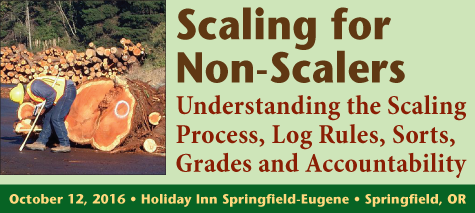Scaling for Non-Scalers

Agenda
Start Date: October 12, 2016Location: Springfield, OR
Wednesday, October 12, 2016
9:00 Scaling Bureaus: How they operate and their role in log markets – Tom St. Laurent
- How bureaus fit into the log buying and selling process
- Represent both the log buyers and sellers
- Apply log scaling rules
- Provide qualified scalers
- Serve as independent third parties
9:30 What does a log scaler do? Mike Belfry
- How scalers fit into the log transaction process (only measure volume, not value)
- What is their relationship to log buyers and sellers
- Different points in log transport where scaling can occur
- What is log volume and how is it calculated?
- What are the specific measurements and data collected on a typical log?
- Log documentation
- Understanding gross and net volume
- Why did my load scale out at a lesser volume? Reasons for volume deductions
10:30 Break
11:00 Northwest Log Scaling Rules: Applying uniformity and standardization within the Doug-fir processing area – Tom St. Laurent
- Function and role of the rules
- What they cover
- How they are maintained and revised
11:30 Special requests: Using procedures in addition to the NW Log Scaling Rules – Tom St. Laurent
- Why special requests are made
- Common examples
- Documenting special requests
Noon Lunch
1:00 Understanding log grades and sorts – Mike Belfry
- What is the difference between grades and sorts?
- Why do sorts vary from company to company?
- What is the difference between a good #2 sawlog and a rough #2 sawlog
- What is the pulp sort?
- What is a cull?
2:00 Break
2:15 Log accountability: Tracking the log load from landing to mill – Mike Belfry
- How is data collected? Load receipts, weight reports, sample scales, sample expansion, log tags, scale tickets and certificates
- Understanding the paperwork: Examples will be provided of load receipts, scale tickets and certificates and each form will be reviewed in detail.
- What are the standard procedures for documentation and changes?
- How is the data stored, disseminated and then accessed by clients?
3:45 Catch-all short topics – Mike Belfry and Tom St. Laurent
- Difference between westside and eastside scaling
- Understanding cubic measurements
- Deciphering overrun and underrun
- Volume conversion factors
- Using taper factors and actual taper
4:15 Adjourn

